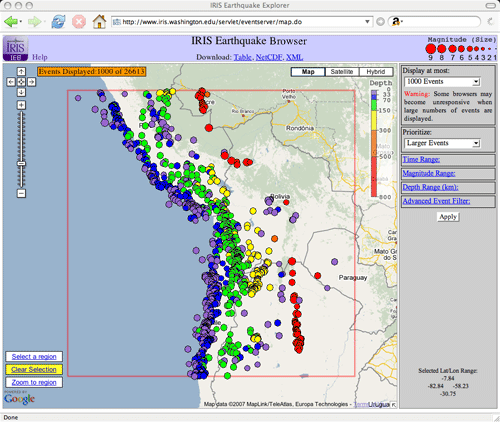Web Utilities
Tools for accessing seismic data and metadata
New website organizes Web Utilities
The IRIS DMS develops Web Utilities for accessing seismic data and related metadata. New utilities include the MetaData Aggregator (MDA) and the IRIS Earthquake Browser (IEB).
IRIS Earthquake Browser

The IRIS DMC is pleased to announce the release of a new generation of web based earthquake query tool – the IRIS Earthquake Browser (IEB). The IEB combines the DMC’s large database of earthquakes with the popular Google Maps web interface. The IEB is useful both educationally and as a research tool. With the IEB you can quickly find earthquakes in any region of the globe and then import this information into the GEON Integrated Data Viewer (IDV) where the hypocenters may be visualized in three dimensions.
Web Utilities Information
Assembled Data Request Form
A Web form for requesting assembled data sets.
BUD Interface
A Web interface for searching and requesting data from the near real-time BUD system. Data is delivered in miniSEED format. BUD data can be accessed by the BUD Web interface, LISS client, or DHI client. One can itemize primary functions, view waveforms, check latency, continuity, request data, etc.
Dataless Request Form
The WebRequest tool allows users to compose breq_fast-style requests and send them directly to the DMC.
Event Search
Pre-assembled event maps and lists are available for the past 24 hours, 7 days, 30 days, and 1 year.
IRIS Earthquake Browser
The IRIS Earthquake Browser (IEB) is an interactive map service for viewing Earthquake Epicenters superimposed on a map of the world. Data can be exported from the IEB and viewed in 3D with the GEON Integrated Data Viewer. The IEB is useful both educationally and as a research tool.
MetaData Aggregator
The MetaData Aggregator (MDA) returns metadata summaries from the IRIS DMC database.
NetDC Request Format
Another e-mail based request format. Similar to a BREQ_FAST request in format, NetDC allows users to query or request data from more than one networked data center with only one e-mail. Request routing is handled internally by every participating network data center.
Seismic Monitor
Seismic Monitor allows you to monitor global earthquakes in near real-time, visit seismic stations around the world, and search the web for earthquake or region-related information.
SeismiQuery
A Web interface into our Oracle database of data holdings including all timeseries information and all meta data, like responses, sensor locations, etc. Users are encouraged to search the database before making a request. SeismiQuery is also used to extract channel response files and can be used to make data requests (like BREQ_FAST).
SPADE (now SPUD)
The Searchable Product Archive and Discovery Engine (SPADE), provides a permanant data products archive that is searchable by product-specific metadata fields. *Note: SPADE has been replaced with SPUD.
Virtual Networks at the IRIS DMC
A virtual network is a group of stations and/or seismic networks, representing an affiliation that goes beyond the traditional bounds of seismic networks to represent an umbrella organization or initiative.
WebRequest
A Web form used to submit BREQ_FAST-style requests directly to the DMC. This tool does NOT query the database. There is a BREQ_FAST request generator within SeismiQuery that accesses the database before generating a request. This way, the user knows exactly what they will be getting when their request is fulfilled.
WILBER II
A Web interface for searching and requesting data from our SPYDER® and FARM archive. Data is delivered in SEED, miniSEED, SAC binary or SAC ASCII files.
Software Help
The IRIS DMC develops software to access and display seismic data. If you don’t know what software to use, then try the IRIS Data Tools Wizard.
Quick Link
by Tim Knight (IRIS Data Management Center)






